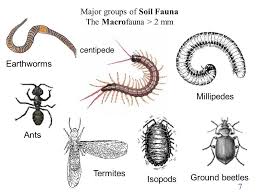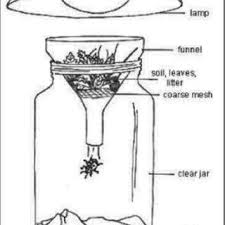Macrofauna
Overview
Macrofauna are the animals in the soil that can be seen by the naked eye. Macrofauna range from sizes of around 2mm to 20mm. These species easily move around in the soil and change the structure of the soil. Common species would be earthworms, myriapods, spiders and more. Macrofauna are important in the process of mixing soil and creating spaces within the soil.

Macrofauna can have many roles in the soil such as soil engineers; who shape and structure the soil, shredders; who breakup organic matter and predators. Macrofauna can also be used to determine soil quality due to their direct involvement in the soil.
Sampling methods
Samples are taken by using the Berlese Funnel method, a method that forces fauna down a tunnel into a collection vessel due to their negative reaction to light.

Soil and soil litter are held up by a coarse mesh that allows the fauna to crawl through. Because of the nature of most arthropods, the heat lamp at the top drives the animals down the funnel and into the collection container. This seperates the fauna from the soil making it easy for population counts and individual species examination.
Common Macrofauna
- Earthworms
- potworms
- springtails or collembola
- mites
- fly larvae
- beetles
- millipedes
- centipedes
- isopods
- ants
- spiders
Earthworms make up about 80% of macrofaunal abundance, alongside springtails, potworms and mites that are also extremely common.